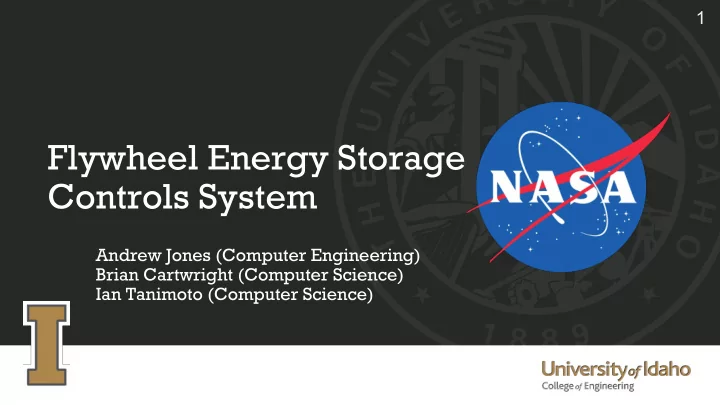

1 Flywheel Energy Storage Controls System Andrew Jones (Computer Engineering) Brian Cartwright (Computer Science) Ian Tanimoto (Computer Science)
2 Project Goal Finish the multi-year Low Speed Flywheel project ● Develop accurate and precise control structures to safely ○ accelerate and stabilize the flywheel rotor Identify strengths and weaknesses of existing code ○ Design and develop improved control code ○ Close the book on the Low Speed FESS so future teams ○ can focus on the High Speed design Advise on changes needed for the High-Speed ● Flywheel controls
2 What is a Flywheel? A flywheel is a mechanical device that stores ● rotational energy. The faster it spins, the more energy it stores. The UIFESS uses an inside-out arrangement, ● with the rotor on the outside of the stator. This allows the rotor to have a larger radius, increasing the system’s energy capacity.
3 Resources Used Software ● Texas Instruments Code Composer Studio ○ ControlSUITE Library ■ Digilent Waveforms ○ Hardware ● TI Delfino 335 Microcontroller ○ KD-2306 Displacement Sensor ○ Kevin Ramus’ Power Electronics PCB ○ SASB Demonstrator Unit ○ Digilent Explorer Board ○ Power Supply Unit x3 ○
5 Completed Work Achieved levitation in a single axis ● Built the test bench according to diagrams received from Kevin Ramus ○ Solved issues with the wiring setup and power requirements ○ Fully debugged the single-axis stabilization code ○ Ran the code on the SASB test setup ○ Completed testing of stabilization code in one axis ○ Designed algorithms for acceleration and deceleration ● Reviewed dual-axis stabilization code ● Expands the functionality of the working single-axis code ○ Should be trivial to get working once the prototype is assembled and balanced ○
6 SASB Hardware Setup
7 Discoveries since last review Finished testing the SASB code ● There was a mysterious 5-second-periodic offset when we first ran the code. ○ Investigation revealed that it was caused by a debugging function left in by the previous team. The code works as expected with that re-commented-out. The strength of the SB & SASB’s pulling force is determined by the duty cycle of the ○ direction pin, not the direction of the direction pin. 50/50 timeshare is weakest, 100/0 in either direction pulls most strongly. This is usually not the case with the FRRM. There were inaccuracies in the wiring diagram provided to us ○ The Pololu’s ground and 24V bus positions were reversed ■
8 Work for Future Teams Assemble and wire the flywheel ● Perform 2-D stabilization testing on flywheel ● Understand and finish the FRRM code, incorporate acceleration ● Test the acceleration code for real ● Optimize algorithm and resource usage ● Use dual-core capability of Delfino 77d to replace one 335 ○ Investigate the SASB “sticking” problem ○ Begin adaptation for High Speed FESS ●
9 Cost of Potential Replacements Resolute Absolute Ring Encoder - $2600 ● Delfino 335 MCU - $28.31 per unit ● ControlCARD - $69 per unit ○ Dock - $99 per unit ○ Delfino 77d MCU - $41.49 ● ControlCARD - $159 ○ Dock - $219 ○ KD-2306 Displacement Sensors: $1800 per unit ● Power Electronics PCBs - ~$66 per unit ● Pololu Power Converters - $64.95 per unit (or $584.50 for 10) ●
Recommend
More recommend